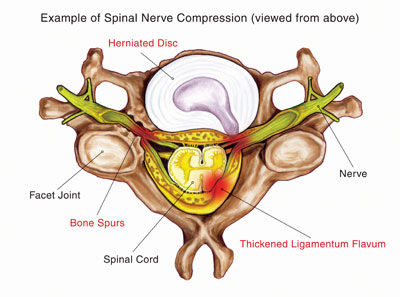Transforaminal Epidural Steroid Injection/
Selective Nerve Root Block (SNRB)
Diagnostic and Therapeutic Benefits for Neck and Back Pain
A selective nerve root block is a diagnostic test performed to determine if a specific spinal nerve root is the potential source of neck or low back pain. Besides a SNRB's diagnostic benefits, some patients experience pain relief.
The procedure involves injecting a local anesthetic and corticosteroid into the foraminal space. A corticosteroid is a powerful, slow-releasing, and long-lasting anti-inflammatory medication effective in reducing inflammation. The foraminal space, or neuroforamen, are nerve root passageways naturally created between two vertebral bodies.
Causes of Neck and Back Pain
There are many spinal problems that can cause nerve root compression, irritation, and inflammation. As depicted in the illustration, a herniated disc or bone spurs (osteophytes) can compress fragile spinal nerve roots in the neck or low back.

Patient Procedure Preparation
In advance of your procedure appointment, our medical team provides you with instructions specific to you and medications you regularly take.
If you take blood-thinning medication, such as Coumadin, Plavix, aspirin, etcetera, please notify our medical team. Certain drugs must be stopped several days before your procedure.
Possible Risks and Complications
A selective nerve root block, like other medical procedures, may present risks. Complications include risk of infection, low blood pressure, headache, injury to nerve tissue, and allergic reaction to medication.
What to Expect: The Procedure and After
Upon arrival at the treatment facility, our nurses meet you in the preoperative area. If necessary, medications to relax you are given intravenously (IV). Depending on the facility where your procedure will be performed, Dr. Assil allows one family member to be present in the operating room.
In the operating room, you are comfortably positioned and a cushion is placed either under your chest or abdomen. Positioning and cushion placement is dependent on whether you are undergoing a cervical (neck) or lumbar (low back) SNRB. Next, the skin area is cleaned with a sterile soap. A local anesthetic is injected and given time to take effect.
Using fluoroscopic guidance (real time x-ray), the doctor proceeds with the procedure and places the needle tip at the target area. The doctor confirms the needle tip is properly positioned visually and fluoroscopically. He then injects a small amount of contrast (dye) to ensure correct spread. Next, a low volume anesthetic / steroid solution is injected into the specific location. Rarely is pain increased during the injection. However, our medical team is dedicated to making you as comfortable as possible. A small Band-Aid covers the injection site.
Depending on the number of spinal levels injected (usually 2); the procedure takes 15 to 20 minutes. Afterward, in the recovery area, you are closely monitored and given a snack.
Before you are released home, our medical team provides you with written home care instructions. In general, you can expect one of the following:
- No pain relief
- Pain is relieved for a few hours, or days, and returns
- Pain is relieved, returns for a short time period, and then improves again
Conclusion
A member of our medical team will telephone you 24 to 48 hours after your selective nerve root block to follow-up. We recommend you keep a daily journal of your pain level and other symptoms following your procedure. Please be specific and keep in mind where pain and symptoms are in relationship to the injection site. The pain diary will help you provide your doctor with detailed information about your treatment progress when you come back for your follow-up office visit.
Our multidisciplinary pain practice is
interventional and comprehensive.

Some Conditions We Treat
- Herniated Disc
- Peripheral Neuralgia
- Post Laminectomy Syndrome
- Spinal Stenosis
- Spinal Spondylolisthesis
